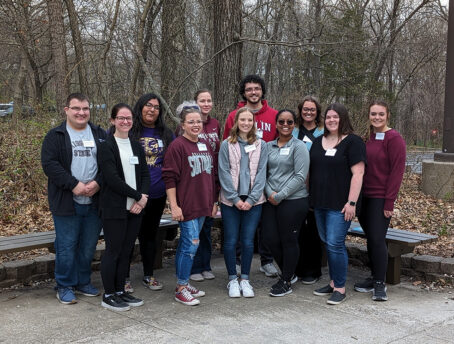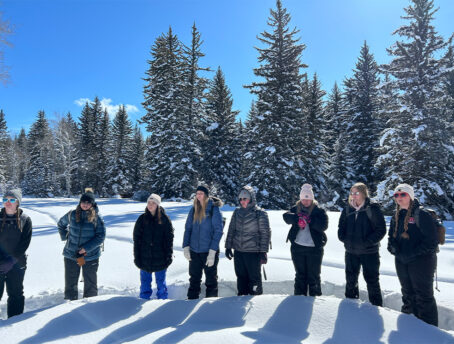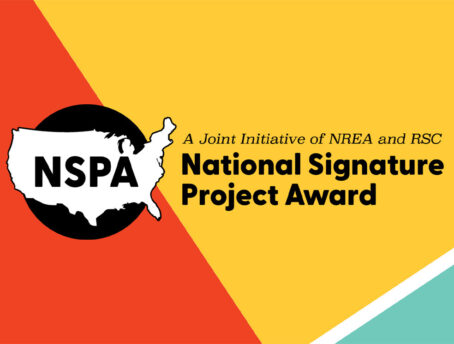It’s a sunny spring day alongside the Illinois River at Waltham Elementary, and in the STEAM classroom students are taking full advantage of the changing of the seasons. Brittany Culjan and Kathy Schultz, who co-teach STEAM (STEM + Art) together, are always looking for ways to connect their students to their local environment and community. Recipients of the ROOTed in Place Grant, kindly supported by Compeer Financial, Brittany and Kathy are utilizing the grant to continue to grow their school garden and market unit, in which multiple grade levels work together throughout the year to grow, process, market, and sell popcorn grown just outside of their classroom.
Kathy and Brittany both love trying new things in their teaching, and bring an open mindset to incorporating nature and agriculture into lessons. In an early morning lesson, kindergarten students were learning to be botanists. First, they collected lots of plant specimens from the school grounds, then sorted and identified what they could. Next came a deep-dive into their shape, color, and form, helped by magnifiers, and finally the plants themselves were rubbed on the paper to produce dandelion-yellow suns, hearts, and rubber ducks. “They're discovering something new every time we take them out there,” shares Kathy.

The idea for the popcorn project came from their school board president, whose family business includes growing and selling popcorn. With help from other staff, including the superintendent and instructional coach, they got a field planted and since then the project has taken off.
With this grant, Kathy and Brittany will be able to keep up with the increasing potential and popularity of their agriculture-in-STEAM lessons. The duo were in desperate need of gloves, kid-sized tools, and will now be able to establish a greenhouse and rain barrels. This past year, they also grew other vegetables, establishing a farm market - including a subscription box, with produce like potatoes, garlic, and tomatoes.
Popcorn, then, gave them an opportunity to build on top of the existing excitement around studying with and engaging in the growing process. This has included expanding into marketing and sales, with help from other staff around the school. Brittany reflects that “since we've been here, the goal has been to teach the kids through K-8 every single aspect of how the seed grows, of ‘what we do with it once it's been planted,’ ‘how do we profit,’ ‘how do we market it?’” The pair has been learning alongside their students; Brittany notes that “they don't come in knowing any of this stuff. We came in not knowing any of this stuff. . . we kind of cultivate an area where it's okay to have ridiculous ideas and try anything.”
Trying anything has paid off, both in learning and in successfully creating and selling a product that people want to buy. First comes planting, then harvesting and processing a large amount of kernels. Jonah, a third grader, notes the independence he was granted in planting in the school garden: “I thought it was cool that we got to plant the seeds by ourselves and water them.” In late summer, 6th grader Quinn describes her classes’ role: “For P.E. we went out and shucked the corn and put it all in baskets and brought it here.” Always the innovators, this year the 6th graders also expanded to grinding some corn for tortillas and chips.
For marketing and sales, the ‘arts’ in STEAM came readily into play. 6th grader Gemma recalls that “we shopped online and put things in it to go with the name. There was Sunny Days– we made the popcorn yellow, and put some orange sun sprinkles in and marshmallows for clouds.” Those had to match up with logos, where students practiced graphic design: “We went on Canva and made little logos to go with our popcorn.” These were then sold in the school concession stand at sporting events and concerts, and other special events. “When it was sold for Read Across America week, we sold out. It was awesome” offers Quinn.
Co-teaching STEAM between Kathy (Art) and Brittany (STEM) combines each of their teaching skills, but a shared belief in student-led learning and Place-Based Education multiplies their joint impact. Their role in the project is simple: “it’s student led– that's all I got. I mean, truly. We are the facilitators of the whole thing, but those kids do it all” summarized Brittany. This follows a general ethos the two share, where they seek to empower their students to make decisions and engage in trial-and-error themselves. “We'll say to them, we've never done this before. You're the first group that's doing this. So we're going to do it together and we hope we win” reflects Kathy.
Kathy, pointing to a series of buckets with mesh tops, offers a salient example: “Those are buckets that we cleaned the corn with that are $5 buckets from Menards or wherever. It was the eighth grade boys who made that system with the smaller holes to sift the corn through and get rid of all the shoals or shells. And we didn't have that idea. We said to the boys, ‘what could we do?’ and that's what they came up with.” The process worked, and when teachers and students alike run into an impasse they turn to other staff members or community assistance.


Like any winning enterprise, the fun and new excitement generated by the popcorn project has brought in additional collaborators. Compost bins to produce high-quality soil in the school garden sit just outside of the STEAM room, and environmental services staff help students load the bins for their grade each day after lunch. When a concert was upcoming at the school, the students worked with the music teacher to produce themed packages and flavors that matched the songs. And of course, they find time to enjoy the fruits of their labor: “It was really fun while we were doing it. We got to pop our own popcorn in the microwave and it was really good. It tasted really good, it was fresh” describes Gemma.
Cassie, a third grader, put the whole project and what it’s like to learn in STEAM Class in even simpler terms: “We do some amazing things with stuff we grow, and things we do for other people.” The popcorn project has been a catalyst for connecting students to their local community, in addition to a joyful and engaging learning experience. Everyone involved is grateful for the support from administrators, buy-in from the students, and the generous support from the Compeer Financial ROOTed in Place grant project.
Trusting in each other and keeping an open mind, Kathy and Brittany form a tag-team that students love. For students like Cassie, it’s noted and appreciated: “They love to do new things and have fun with us. They are very funny. She’s like a plant: she can grow us, help us, and make us learn new things.”
Rural Schools Collaborative is thrilled to support Brittany Culjan and Kathy Schultz, of Waltham School District 185, through the ROOTed in Place grant. The STEAM duo are truly rooting their students in their rural place, while teaching valuable life skills and connections to tie back into the classroom STEAM curriculum. While involving all grades and making lessons interdisciplinary, the agriculture-focused program is a school-wide project making a community-wide impact. Rural Schools Collaborative is extremely grateful for Compeer Financial’s support of the Grants in Place Program and the one-time ROOTed in Place Grant.




